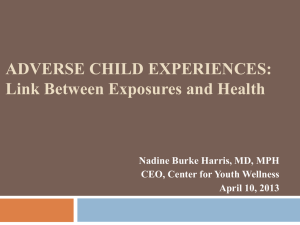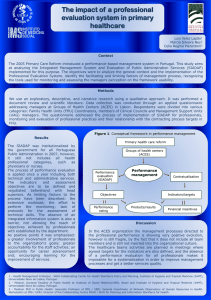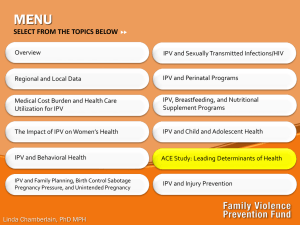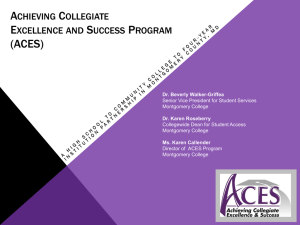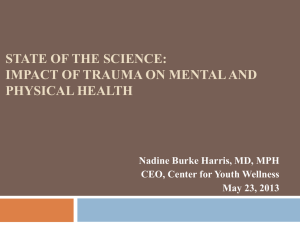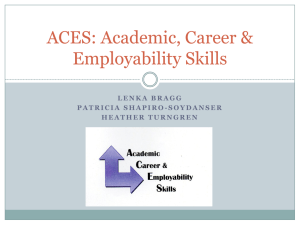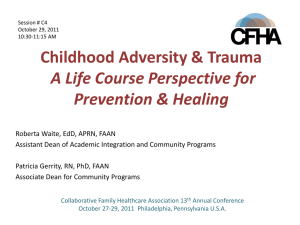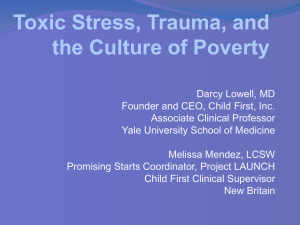Revised Keynote Presentation - Children`s Trust Foundation
advertisement
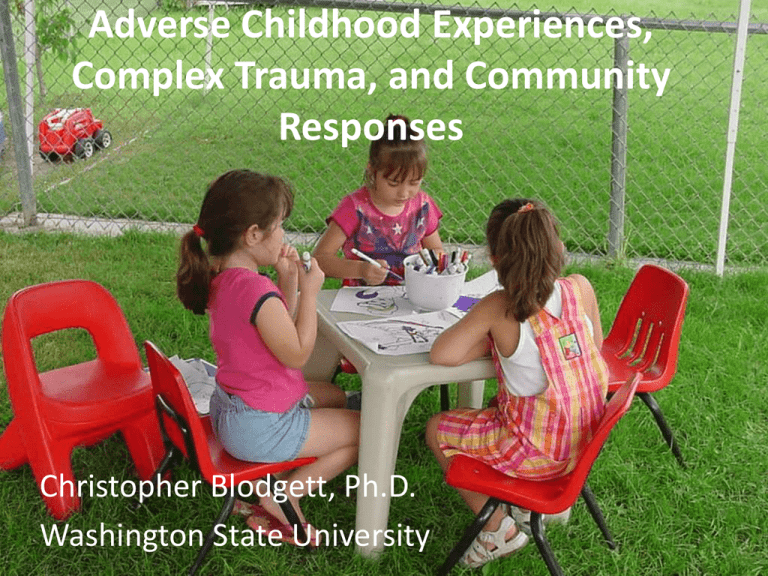
Adverse Childhood Experiences, Complex Trauma, and Community Responses Christopher Blodgett, Ph.D. Washington State University Five Takeaways for Today 2 Quality relationships fix many things Adverse Childhood Experiences, are the public health problem facing America Understanding trauma can guide what we do to make things better Trauma is the least interesting thing you can know about another person We have to look to each other and unusual partners for a problem this big Understand Trauma but Build Resilience 3 Resilience- positive adaptation despite adversity In early childhood, successful secure attachment In later childhood, mastery of school and establishing meaningful peer and adult relationships In adults, meaningful intimate and loving relationships A virtuous cycle- Reduces exposure to vulnerability and increase access to protective resources Building Resiliency as the Positive Health Goal 4 Focus on positive growth in addition to reduction of risk Harm reduction as the goal Adopt a developmental and an ecological approach to assessment and provision of interventions Commit to persistent efforts with high risk families Build community capacity as the principal resource Relationship is the Evidence-Based Practice 5 Trauma results primarily from disrupted relationships Focus on relationship as the vehicle for life success Attachment key to well-being across the life span Critical role of core caregiverinfant relationships Early learning creates persistent but potentially modifiable responses Progressive role of extended caregivers and intimate relationships Attachment: Can I Depend on You When I Need You? Attachment is the maintenance of a desired distance to a caregiver both physically and emotionally. The desired distance depends on the situation. The caregiver as a safe haven soothes and comforts activation and creates readiness to explore in the child Child may be ‘activated’ (seek closer proximity due to fear or uncertainty) by internal/external cues The belief that the caregiver will be available as a secure base if needed provides a child the safety to explore their world Ideally, activation stops when the child’s desired distance is exceeded by the actual distance 4 Core Principles of Attachment Attachment is an innate motivating force In order to learn, you have to feel safe and free to explore 1. 2. 3. 4. Fear and uncertainty activate attachment needs Attachment offers a safe haven Attachment offers a secure base You build bonds by being accessible and responsive Isolation and loss are inherently traumatizing Directions of Attachment View of Self is positive Dismissingavoidant-I can’t rely on you, so I only rely on me. View of others is negative DisorganizedI’m not okay with you and I’m not okay without you. My fear is unsolvable. Secure Attachment - I can rely on me and I can rely on you Preoccupied AmbivalentI can’t rely on me, so I rely on you View of Self is Negative View of others is positive User’s Manual for Your Brain 9 Principle 1: Our brains are designed to benefit from rich and supportive intimate social relationships. Principle 2: Brain function is hierarchical. We feel and then we think. Principle 3: Brain systems change with use throughout life. Toxic Stress Places Health at Risk 10 Toxic stress Persistent, unpredictable, overwhelming Adverse Childhood Experiences as the origins of toxic stress Complex trauma as adaptation and survival Toxic Stress Places Brain Development at Risk 11 1. 2. 3. 4. 5. Access to adequate stimulation at key times Elevated stress hormone levels can change brain structure Functional immaturity of the threat-arousal management system Brain development follows use Survival trumps learning Complex Trauma and ACEs 12 The process of exposure to ACEs and the process of adjustment. The ‘complex’ in complex trauma risk: Early exposure at times of critical development Multiple risks Unpredictable and persistent Who you love is who you may not be able to count on Natural responses to extraordinary circumstances. Complex trauma involves common challenges and responses that can be understood and guide our actions. Natural Responses to Extraordinary Circumstances 13 Sense of self and ability to influence the world Not feeling worthy of love, not trusting love Feel incapable of having a positive impact on the outside world Diminished sense of self worth = diminished persistence in effort, giving up on or distorting relationships Self-regulation Arousal and hyper-vigilance Survival and automatic behaviors- aggression, withdrawal, dissociation Poor impulse control Trauma impairs emotional learning- constricts response and ability to form relationships We Swim in Adversity The Adverse Childhood Experiences Study 14 Substance Abuse Parental Separation/Divorce Mental Illness Battered Mother Criminal Behavior Psychological Abuse Physical Abuse Sexual Abuse Emotional Neglect Physical Neglect 27% 23% 17% 13% 6% 11% 28% 21% 15% 10% ACEs Have a Dose Effect on Health • With four or more categories of childhood exposure, compared to adults with no ACEs – 4- to 12-fold increased alcoholism, drug abuse, depression, and suicide attempt – 2- to 4-fold increase in poor self-rated health – 3- to 4-fold increase in chronic illness (heart disease, liver disease) – Earlier death with >6 ACEs Women % Men % Total % 0 35 38 36 1 25 28 26 2 16 16 16 3 10 9 10 4 or more 15 9 13 (ACE Score) 15 Impact-ACE Risk Pyramid We don’t know much of what we need to know right now Copyright WSU AHEC 2012 Reproduction with attribution permitted 17 How Do We Move to Community Responses to ACEs and Trauma? 18 Each of us has to name the problem Trauma compromises our universal systems caring for children Common need builds alliances Education, primary health care, youth development Helping professionals understand their role - appropriate response to trauma Awareness, trauma informed planning, surveillance and referral, role of natural relationships in repair Our initial experiences in early learning and K-12 education- Building the case, moving to action Spokane Study ACEs Exposure in Elementary Aged Children • 2,100 randomly selected children in 10 elementary schools • >200 teachers, counselors, and building administrators provided knowledge of children’s risk • 5 Title I and 5 Non-Title I schools • Risk is greater as poverty increases •First study of its kind Parents Divorced/Separated Residential Instability Domestic Violence Witness CPS Involved Jailed Family Member Substance Abuse in Family Member Basic Needs Mental Health Disorder in Family Member Physical Disability in Family Member Community Violence Exposure Parent/Caregiver Death Lifetime 36% 9% 9% 9% 9% 7% 7% 5% 3% 3% 2% Complex Trauma Risk in the Spokane Students Lifetime ACE Exposure Past 12 Month ACE Exposure 55% 81% 23% 12% 10% 4% 12% 2% None One Two Three or More Odds for Academic and Health Problems with Increasing ACEs in Spokane Children Academic Failure Severe Attendance Problems Severe School Behavior Concerns Frequent Reported Poor Health 3 5 6 4 Two ACEs N=213 2.5 2.5 4 2.5 One ACE N=476 1.5 2 2.5 2 No Known ACEs =1,164 1.0 1.0 1.0 1.0 Three or More ACEs N =248 Percent of Students with One or More Academic Concerns by ACE Exposure 100% 90% Percent of Students with Academic Problems 80% 70% 60% 50% 40% 30% 20% 10% 0% No Known Adverse Events One or More Academic Concerns 34% One Reported Adverse Event 56% Two Reported Adverse Events 71% Three or more Adverse Events 80% Readiness to Learn and ACEs 23 RTL program RTL ACEs Scale = Adapting other assessment Basic Need information in an adverse framework Challenged data still produces powerful effects Legal Problems Data entered by more than 100 different service providers Data based on establishing a relationship to collect optimal data Copyright WSU AHEC 2012 Reproduction with attribution permitted Parenting Concerns Single Parent/Living Away from Parents CPS/Abuse Concerns Homeless/Homeless Risk Family Safety/Family Violence Family Substance Abuse ACE Exposure in Readiness to Learn N=5,443 RTL Students 50% 45% 40% 35% 30% 25% 20% 15% 10% 5% 0% N=5443 RTL Students No Reported ACEs 19% One ACE 32% Two ACEs 22% Copyright WSU AHEC 2012 Reproduction with attribution permitted Three ACEs 14% Four or More ACEs 12% 24 RTL- ACEs and Odds Ratios for Academic Risk Academic Failure Poor Attendance Four or More ACES N=663 Three ACEs N=756 2.0 5.3 3.1 6.5 1 3.0 1.5 2.0 Two ACEs N=1,141 1 2.5 1.6 1.8 One ACE N=1,612 1 1.6 1.2 1.2 No Reported ACES N=1,020 --- 1 1 1 Copyright WSU AHEC 2012 Reproduction with attribution permitted School Behavioral Behavior Health Problems 25 RTL-ACEs and academic success Copyright WSU AHEC 2012 Reproduction with attribution permitted 26 RTL students and social emotional distress Copyright WSU AHEC 2012 Reproduction with attribution permitted 27 Screening for ACEs in Head Start Children • Parent report • Adaptation of original ACE screen (0-9 items) • Average ACEs – Child M= 2.6 – Parent M=4.0 – 44% of children and 75% of parents have 3 or more ACEs Copyright WSU AHEC 2012 Reproduction with attribution permitted 28 ACE Exposure Groups and Mean Caregiver Initial DECA Scores N=104 Behavior Concern Total Protective Factors Attachment Self Control Initiative 40 45 50 55 60 65 70 Initiative 47 Self Control 46 Attachment 45 Total Protective Factors 45 Behavior Concern 65 3-4 ACEs 54 54 52 53 58 1-2 ACEs 54 53 54 53 57 No ACEs 50 53 55 51 55 5 or more ACEs Why There is Reason for HopeTrauma Informed Practice in Education Social support and resources build resiliency at any age. Resiliency buffers the effects of trauma. Creating safety and predictability creates opportunity for new learning. Understanding trauma creates opportunities for new behaviors. Teachers can create powerful relationships. Managing trauma’s effects may result in increasing success for systems. 30 A Roadmap for Change in Education as One Example Response to Intervention as a public health principles adapted into education settings Universal adoption of social emotional learning and trauma informed actions to guide decision-making Trauma informed assessment and tailored response to children and families most in need Sustainable interventions to prepare children to benefit from universal education and supports Coordination of more intensive supports when required
